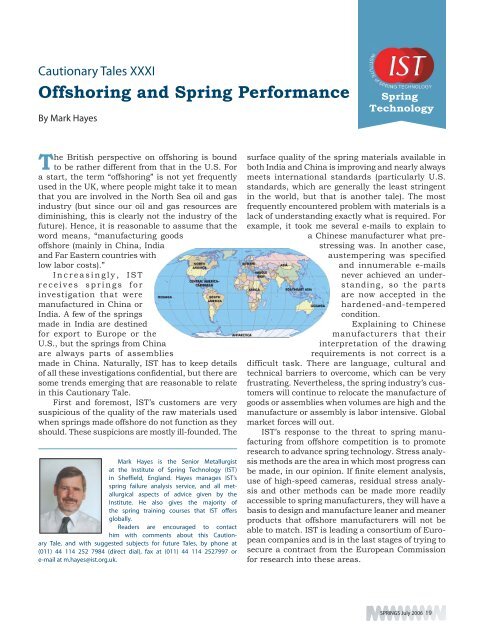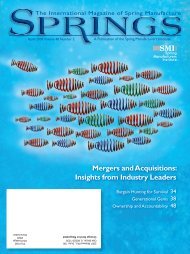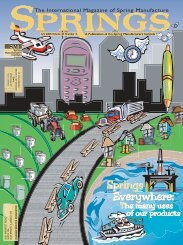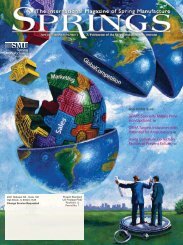Solid Height - Spring Manufacturers Institute
Solid Height - Spring Manufacturers Institute
Solid Height - Spring Manufacturers Institute
You also want an ePaper? Increase the reach of your titles
YUMPU automatically turns print PDFs into web optimized ePapers that Google loves.
Cautionary Tales XXXI<br />
Offshoring and <strong>Spring</strong> Performance<br />
By Mark Hayes<br />
The British perspective on offshoring is bound<br />
to be rather different from that in the U.S. For<br />
a start, the term “offshoring” is not yet frequently<br />
used in the UK, where people might take it to mean<br />
that you are involved in the North Sea oil and gas<br />
industry (but since our oil and gas resources are<br />
diminishing, this is clearly not the industry of the<br />
future). Hence, it is reasonable to assume that the<br />
word means, “manufacturing goods<br />
offshore (mainly in China, India<br />
and Far Eastern countries with<br />
low labor costs).”<br />
Increasingly, IST<br />
receives springs for<br />
investigation that were<br />
manufactured in China or<br />
India. A few of the springs<br />
made in India are destined<br />
for export to Europe or the<br />
U.S., but the springs from China<br />
are always parts of assemblies<br />
made in China. Naturally, IST has to keep details<br />
of all these investigations confidential, but there are<br />
some trends emerging that are reasonable to relate<br />
in this Cautionary Tale.<br />
First and foremost, IST’s customers are very<br />
suspicious of the quality of the raw materials used<br />
when springs made offshore do not function as they<br />
should. These suspicions are mostly ill-founded. The<br />
Mark Hayes is the Senior Metallurgist<br />
at the <strong>Institute</strong> of <strong>Spring</strong> Technology (IST)<br />
in Sheffield, England. Hayes manages IST’s<br />
spring failure analysis service, and all metallurgical<br />
aspects of advice given by the<br />
<strong>Institute</strong>. He also gives the majority of<br />
the spring training courses that IST offers<br />
globally.<br />
Readers are encouraged to contact<br />
him with comments about this Cautionary<br />
Tale, and with suggested subjects for future Tales, by phone at<br />
(011) 44 114 252 7984 (direct dial), fax at (011) 44 114 2527997 or<br />
e-mail at m.hayes@ist.org.uk.<br />
<strong>Spring</strong><br />
Technology<br />
surface quality of the spring materials available in<br />
both India and China is improving and nearly always<br />
meets international standards (particularly U.S.<br />
standards, which are generally the least stringent<br />
in the world, but that is another tale). The most<br />
frequently encountered problem with materials is a<br />
lack of understanding exactly what is required. For<br />
example, it took me several e-mails to explain to<br />
a Chinese manufacturer what prestressing<br />
was. In another case,<br />
austempering was specified<br />
and innumerable e-mails<br />
never achieved an understanding,<br />
so the parts<br />
are now accepted in the<br />
hardened-and-tempered<br />
condition.<br />
Explaining to Chinese<br />
manufacturers that their<br />
interpretation of the drawing<br />
requirements is not correct is a<br />
difficult task. There are language, cultural and<br />
technical barriers to overcome, which can be very<br />
frustrating. Nevertheless, the spring industry’s customers<br />
will continue to relocate the manufacture of<br />
goods or assemblies when volumes are high and the<br />
manufacture or assembly is labor intensive. Global<br />
market forces will out.<br />
IST’s response to the threat to spring manufacturing<br />
from offshore competition is to promote<br />
research to advance spring technology. Stress analysis<br />
methods are the area in which most progress can<br />
be made, in our opinion. If finite element analysis,<br />
use of high-speed cameras, residual stress analysis<br />
and other methods can be made more readily<br />
accessible to spring manufacturers, they will have a<br />
basis to design and manufacture leaner and meaner<br />
products that offshore manufacturers will not be<br />
able to match. IST is leading a consortium of European<br />
companies and is in the last stages of trying to<br />
secure a contract from the European Commission<br />
for research into these areas.<br />
SPRINGS July 2006 19





